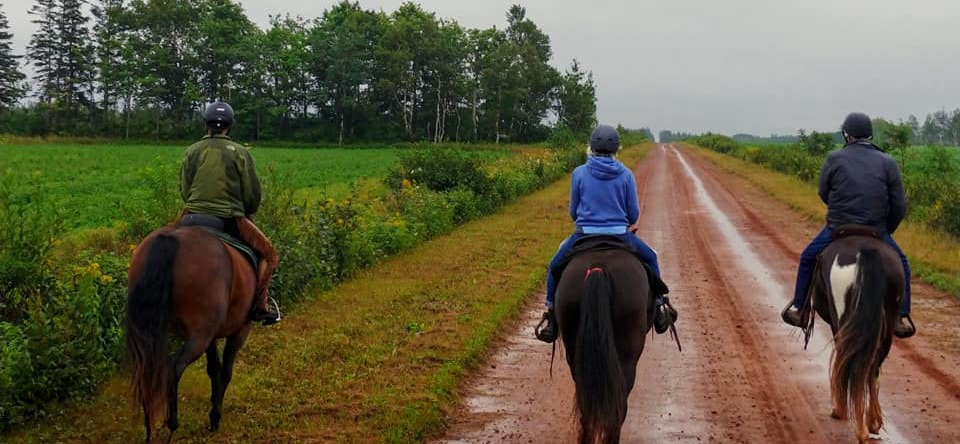
Riding on clay roads in Burton, Prince County

Riding on clay roads in Burton, Prince County
In 2021 and 2022, the Ministry of Transportation and Infrastructure implemented pilot projects designed by PEI Trail Riders. The projects were reviewed by PEITR and the Department in February 2022, and was agreed to have been successful.
In 2023 and 2024, horses were once again be permitted on four segments of the Confederation Trail between July 1 and October 31.
In the fall of 2023, the Ministry conducted a public consultation process with all types of trail users as part of its goal to develop a long-term plan for the Trail. The results of this primary consultation was published in the spring of 2024, and a final report was published in the fall of that year. In the winter of 2025, the Ministry advised that it would be undertaking a consultation to renew its outdated Risk Assessment document for the trail. That report is not expected until sometime in 2026.
In view of the Province's ongoing re-assessment of trail use, equestrian access been renewed for 2025 without including the broad expansion that has consistently been sought by PEITR. We continue to lobby for expansion of access.
Quick Links
Hooves on the Trail was designed to explore the suitability of equestrians as a legitimate/designated user group on the Confederation Trail. The project had a defined start and end date, designated trail segments, and included a strategy for outcome measurement as well as a plan for ensuring the safety and education of all trail enthusiasts.
The Need:
* On Prince Edward Island, there is an absence of publicly-accessible off-road trails that permit equestrian access.
* Horses can travel 20-50 km per day, and horseback riders tend to prefer routes that are relatively long.
* Currently, the only equestrian-accessible, publicly-funded trail system on PEI is the Forest Hill Trail in Kings County, with 7.8 km of mapped trail.
* As is the case with cyclists, equestrians sharing roads with motor vehicle drivers are vulnerable to serious injury. Equestrians strongly prefer to minimize their exposure to car and truck traffic traveling at speed.
Suitability of the Confederation Trail:
* The Confederation Trail is a rail trail, whose construction style (surface tread of rolled stone dust over traditional railway crushed rock ballast – ballast transported from the mainland as the local sandstone was too fragile) is consistent with other rail trails that exist across the nation, many of which are successfully shared with equestrians.
* The Rails-to-Trails Conservancy (the American national voice for the rail-trail movement and which has over 24,000 miles of rail trail on the ground) notes that compacted stone dust provides a surface tread that can accommodate nearly every trail user (the exception being inline skaters).
* The American Association of State Highway and Transportation Officials' (AASHTO) recommends sight lines of 150 ft (45 m) for trails used by cyclists, and of 100 ft (30 m) for trails used by equestrians. The sight lines along the designated sections of the Confederation Trail fall within these guidelines.
* The US Forest Service’s Equestrian Design Guidebook for Trails, Trailheads, and Campgrounds recommends that where there are frequent encounters between horses and other trail users coming from opposite directions, the minimum suggested tread width be 6 feet (1.8 meters). The tread width of the Confederation Trail falls within these guidelines.
* The US Forest Service recommends equestrian trails be a minimum of 8 km, preferably longer. The sections of the Confederation Trail designated for the project vary from 11 km to 14 km in total one-way distance.
Safety and Trail Maintenance Considerations:
* On multi-use trails, communication and courtesy go a long way toward reducing user conflict and making sure everyone enjoys their experience on the trail.
* Each road crossing and parking trailhead will have etiquette signage (i.e. who gives way to whom and a brief description of safe behaviour when meeting other users). Standard trail etiquette requires pedestrians to give way to horses, and cyclists to give way to everyone.
* Across jurisdictions, manure on the trail is the most commonly cited complaint regarding horses on shared-use trails. Equestrians are directed to remove an manure from the main trail tread.
* As with cyclists, equestrians are required to wear an approved helmet when on he trail.
* See the User Guidelines for detailed information regarding how to politely and safely meet other users when out enjoying the trail.
Outcome Measurement:
* Both the Ministry of Transport engineers and PEI Trail Riders monitored the trail surface throughout the pilot period. PEITR volunteers documented the condition of the surface tread via online report submissions and weekly photo-documentation of specific locations.
* A QR code was featured on each etiquette sign, inviting users to respond to a questionnaire regarding their experience on the trail. Survey questions included rating interactions with other users and satisfaction with the surface of the trail.
Mobirise web page maker - Go now